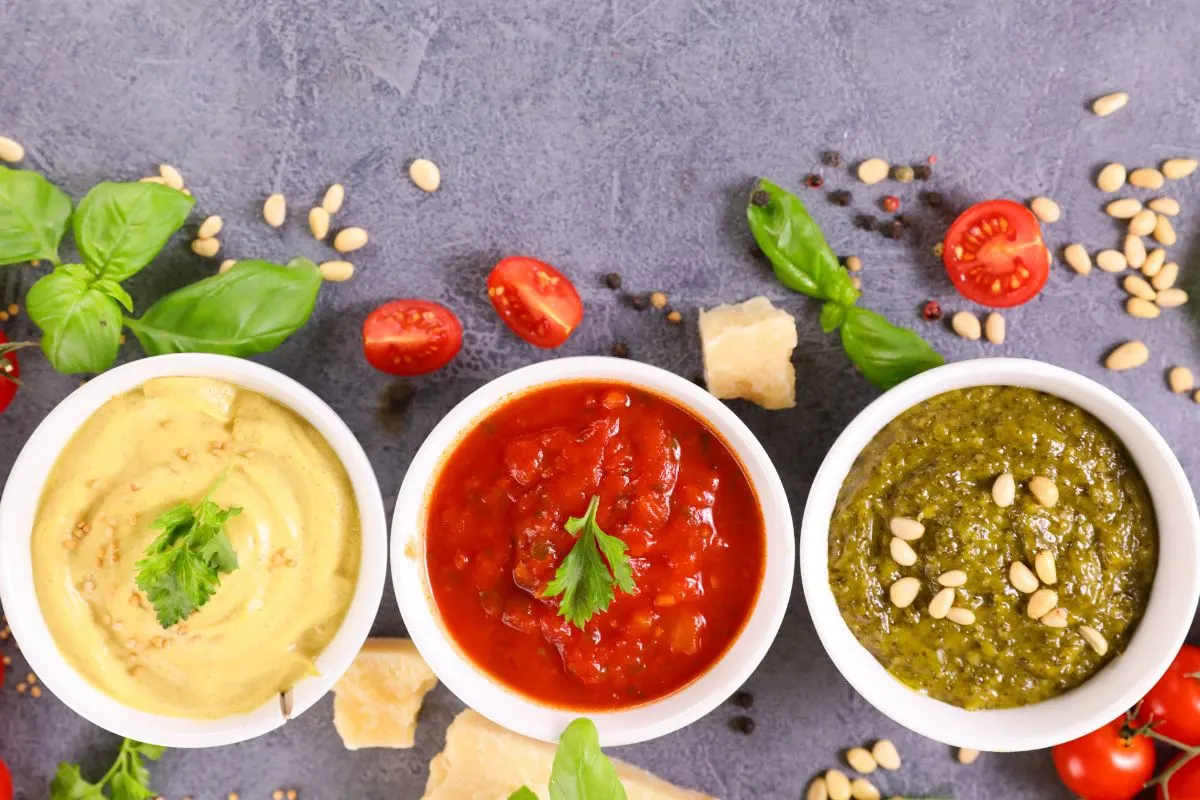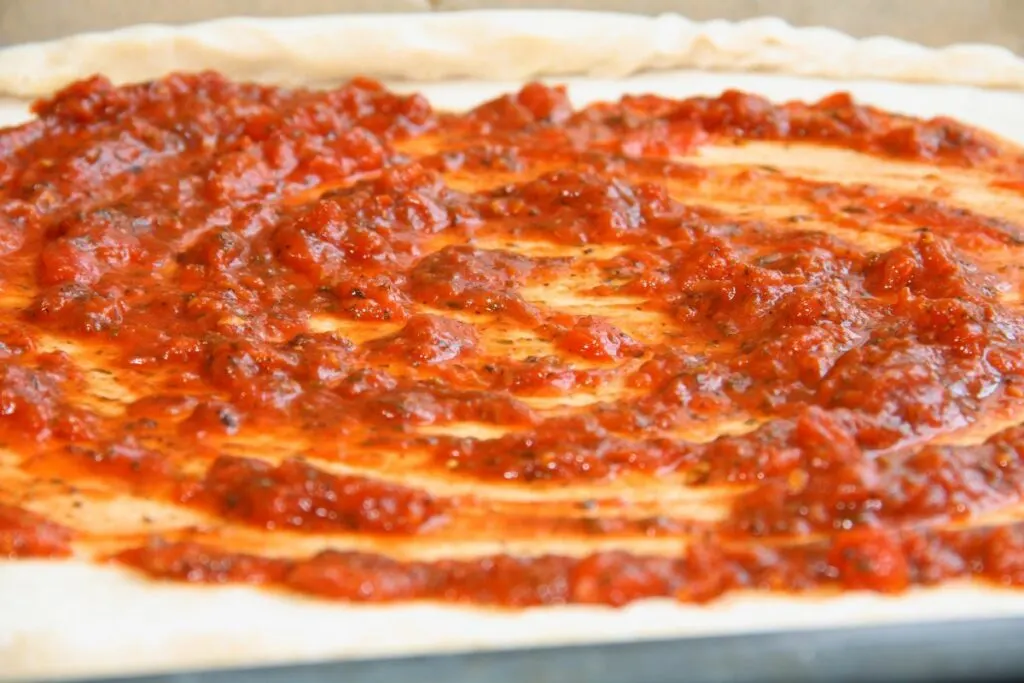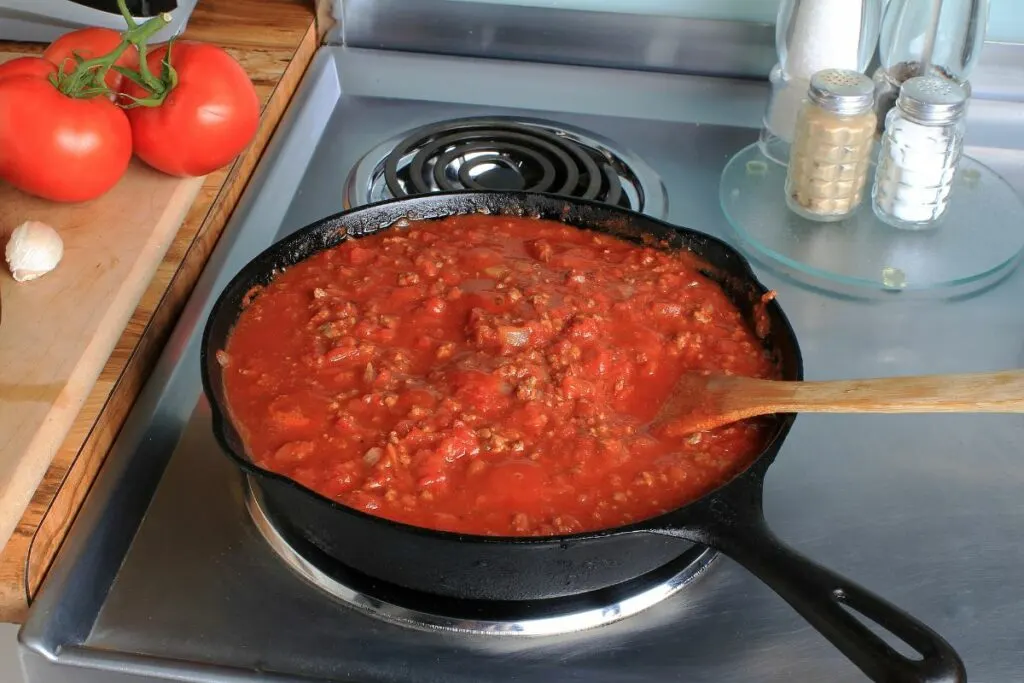One of my pastimes during the lockdown was exploring different toppings for pizza night. I’ve dabbled with pizza sauce and marinara sauce, but when the mood calls for it, I’d often find myself out of what I needed. This is when knowing pizza sauce substitute comes in handy.
You can substitute pizza sauce with leftover spaghetti sauce, make a homemade sauce version, use pantry items, store-bought, and white sauce. But this isn’t all you can use. I’ll go over every single one that can level up your favorite dish!

Jump To
- 🤷 What Makes Up Pizza Sauce?
- 📌 How to Make Pizza Sauce
- 💡 9 Best Pizza Sauce Substitutes
- Homemade Pizza Sauce
- Pantry items: Canned Tomato + Tomato Paste
- Leftover Spaghetti Sauce
- Pantry Items: Tomato Sauce + Tomato Paste
- Homemade “Nomato” Pizza Sauce
- Store-Bought Marinara Sauce
- Oil-Based Pizza Sauce: EVOO or Pesto
- White Pizza Sauce: Bechamel or Alfredo
- Dessert Pizza Sauce: Nutella, Chocolate Sauce, or Nut Butters
- 🧐 FAQs
🤷 What Makes Up Pizza Sauce?
Pizza sauce is a tomato-based sauce that’s spread on the dough before adding toppings and baking the pizza. Some often confuse ketchup and tomato sauce, but they are very different. The main ingredients in pizza sauce are tomatoes and olive oil. The oil adds a rich, fruity flavor that helps to balance the acidity of the tomatoes.
📌 How to Make Pizza Sauce
To make delicious pizza sauce, start with canned crushed tomatoes. I find that they have the perfect texture and consistency for pizza sauce. Add minced garlic, dried oregano, salt, and pepper to taste. Then, add a pinch of sugar to balance out the acidity of the tomatoes. Then, add a splash of olive oil and mix everything together. I let the sauce sit for at least 30 minutes to allow the flavors to meld together. If you have fresh basil on hand, chop it up and add it to the sauce just before using it.

💡 9 Best Pizza Sauce Substitutes
Homemade Pizza Sauce
The most practical way to replace store-bought pizza sauce is to make it from scratch. Ripe pureed tomatoes, tomato paste, and seasonings come together to make a healthier version of the ready-made sauce. Enjoy the ripe taste of fresh tomatoes in every bite. Try this recipe.
Pantry items: Canned Tomato + Tomato Paste
If you have high-quality canned tomatoes, they can provide a suitable substitute for pizza sauce. Mainly used for pasta sauces rather than in pizza, the consistency of canned tomatoes is thinner than desired and comes with a lot of excess liquid. Without altering it, the chances are the pizza sauce will be too thin and make the dough soggy. So, be sure to pulse the chunky bits in a food processor to turn them into a thick and smooth consistency. Adding tomato paste will make it thicker and richer in color and texture.
Leftover Spaghetti Sauce
When you’ve made a ton of pasta sauce and want to use it up, try it as a pizza sauce substitute with just a little bit of alteration. If you compare pasta sauce and pizza sauce, homemade spaghetti sauce does have a thinner consistency than what is called for in a pizza. You can tweak this by pureeing the chunks some more and then straining out the excess liquid. You can also cook it up some more in a saucepan or just add tomato paste to thicken it. Always check the flavor to see if the seasoning needs some adjustment.

Pantry Items: Tomato Sauce + Tomato Paste
If all you have are packets of tomato sauce and paste, then you can combine them to easily make pizza sauce. The bright flavors of tomato sauce with its runny consistency will be easily tapered by the thickness of the concentrated tomato paste. Some tomato sauces have added ingredients like herbs, spices, and seasonings, so when you add the bold flavor from the tomato paste, this means double or triple the strength.
Homemade “Nomato” Pizza Sauce
AIP protocol, vegan, and nightshade-free eaters are familiar with this substitute. This ingenious creation mimics the look and taste of pizza sauce without the usual ingredients. A combination of earthy and sweet root vegetables – onions, carrots, beets, and/or squash are blended with lively seasoning from garlic and fresh herbs. It’s then cooked in red wine vinegar and then balanced off with honey. You can even add coconut milk, but make sure to fix separated coconut milk if it breaks apart before using it.
Store-Bought Marinara Sauce
Using this marinara sauce alternative is a convenient alternative to pizza sauce when you’re missing tomatoes or tomato sauce. Available as a ready-made sauce from the supermarket, marinara is a thick, well-seasoned sauce. Each manufacturer has their own recipe, so check the consistency and flavor before using one. Modify the consistency by adding tomato paste or cooking it on the stove to thicken up. Adjust the flavor by seasoning it to taste.
Oil-Based Pizza Sauce: EVOO or Pesto
This isn’t a direct substitute for a tomato sauce-based pizza, but we just love any kind of pizza with cheese on it, no matter the sauce. This version calls for a drizzle of extra virgin olive oil with roasted garlic and fresh herbs, or pesto sauce directly on pizza dough (or flatbread). This may be an unusual pizza sauce substitute, but it is definitely apropos of a classic pizza. Try this recipe.

White Pizza Sauce: Bechamel or Alfredo
A white sauce base is another typical pizza sauce substitute. Bechamel or Alfredo sauce are good choices for this. Using the best ways to thicken alfredo sauce and bechamel can deliver a delicious spread for the dough before adding toppings. You can even make them vegan with a base using an almond butter substitute. A classic bechamel is a mix of butter, flour, and milk, while a traditional alfredo is a combination of parmesan cheese, butter, cream, and salt. So either would be great if you decide to use them.
Dessert Pizza Sauce: Nutella, Chocolate Sauce, or Nut Butters
We know, we know — you were looking for a savory pizza sauce, but we just can’t help it. Have you ever tried dessert pizza? If not, you should! Dessert pizza is God’s gift to those of us with a sweet tooth. Bake your dough, then lather on Nutella, chocolate sauce, or any nut butter. Top with fruits, nuts, and other confections, and you’ve got yourself a no-fuss dessert from spare pizza dough. Enjoy it with an espresso or a strong cup of tea. Dolce gusto!
🧐 FAQs
White sauce pizza, also known as “pizza bianca,” is a type of pizza that’s made without tomato sauce. Instead, it’s topped with a white sauce made from a combination of butter, flour, and milk or cream.
The most common sauce used on pizza is tomato sauce, which is made from crushed tomatoes, garlic, and various spices. However, there are many other sauces that can be used on pizza, including pesto, barbecue sauce, Alfredo sauce, and even olive oil.
Yes, marinara sauce can be used as a substitute for pizza sauce. Marinara sauce is a tomato-based sauce that’s similar in flavor to pizza sauce, but it’s typically thinner and more liquid.
Some popular substitutes include marinara sauce, jarred pasta sauce, barbecue sauce, pesto, Alfredo sauce, and even olive oil. Each of these sauces will give your pizza a unique flavor, so it’s important to choose one that complements your toppings.
